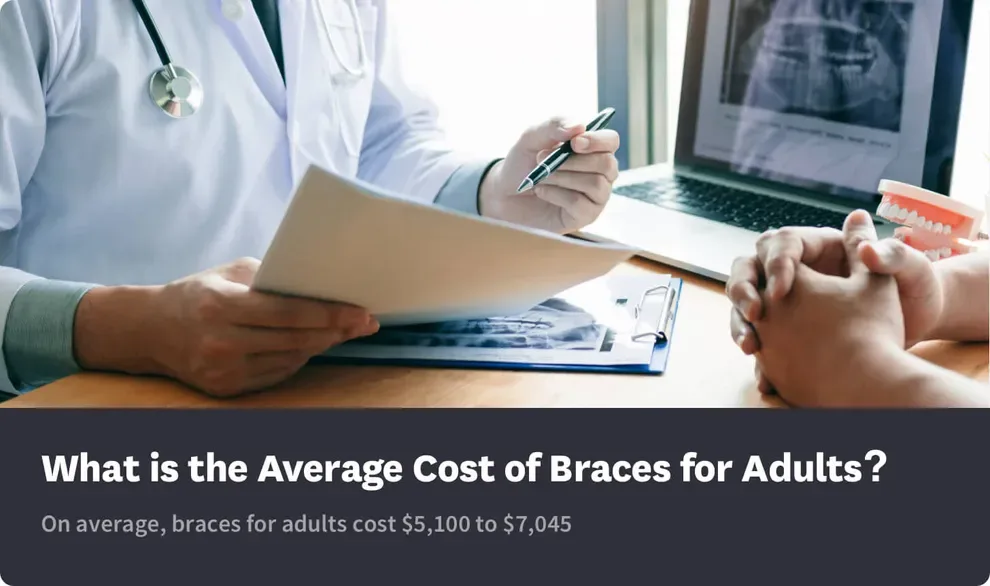Braces for Adults: A Cost Comparison Guide.

Table of Contents
- Baseline Cost
- Special Braces
- Cut Costs
Straightening misaligned teeth isn’t just for kids. Braces for adults come with big benefits, including better oral health and a more compelling smile.
Braces for adults can also come with a hefty price tag, especially if your oral health issues are significant and you need to wear the devices for a long time.
How much can you expect to pay? Let's break down costs.
| Tooth-Straightening Method | Average National Cost |
|---|---|
| Metal braces | $4,500 |
| Ceramic braces | $6,000 |
| Lingual braces | $9,000 |
| Invisalign | $4,500 |
| Byte | $2,099 |
| Laser Bleaching From Your Dentist | $1,000 or more |
| In-Office Bleaching | $600 or more |

What's the Baseline Cost of Braces?
On average, braces for adults cost $4,500. Your final bill could be bigger if your provider tacks on extra fees for services such as these:
Initial visits ($100 to $200)
Dental x-rays ($10 to $250)
Retainers ($200 to $1,000 for the originals and $100 to $500 for replacements)
Your price could also be higher due to your oral health. Severe dental issues include the following:
Significant crowding, which is often caused by a narrow jaw
Impacted teeth
Large overbite or underbite
Asymmetrical teeth
More significant challenges mean longer treatment times. Your team may need to tackle your issues in stages, moving some teeth so others can take their place.
Your team may also need more time to make all of the shifts required to give you the smile you want. All of that added work comes with a higher price.
What About Special Braces?
Your orthodontist may offer a variety of different types of braces. Expect to pay more to customize the way your mouth looks during tooth straightening.
Gold braces: $2,800 to $7,000
Gold braces are shiny, and they're almost impossible to ignore. They sit right on the surface of your teeth, and each time you pull your lips back to smile or talk, they catch the light.
Ceramic braces: $2,800 to $7,000
Ceramic braces are the same color as your teeth, making them slightly harder to see. The metal wire that connects each bracket can shimmer in the sun, but few people may notice the brackets themselves unless they are quite close to you.
Lingual braces: $7,000 to $11,000
Lingual braces also use brackets, but those are glued to the back of your teeth. No one may see these devices at all, but they may notice a difference in how you talk. You may also have some initial difficulty swallowing with lingual braces.
Choosing the least expensive braces option is one way to cut costs. The less your team spends on raw materials, the smaller the number you will see on your bill each month.
Keep your costs low by making smart shopping decisions, and with the right technology, you could get the smile you want at a significantly reduced price.
Cut Costs in 3 Steps
You can't change how much help your teeth need. If you could, braces wouldn't be required at all. But your braces choices can add to or subtract from your bottom line.

1. Shop Smart
Keep your costs low by making smart shopping decisions. Don't get fancy braces with a special look. Opt for the base model for the smallest price tag.
2. Stick to the Timeline
The less time you spend in treatment, the lower your price. Consider this adult braces cost comparison:
Braces worn for 1 year: $2,546
Braces worn for 3 years: $7,637
Braces worn for 4 years: $10,183
Keep your appointments and do everything your doctor tells you to.
3. Take Good Care of Your Teeth
Experts say you can also cut costs by practicing good home care.
Follow instructions. Your doctor will tell you how to care for your teeth during treatment. Follow each step carefully.
Keep your teeth clean. It's hard to brush and floss while wearing braces, but the more you polish your teeth, the better you'll feel.
Handle your brackets with care. Eat abrasive or sticky foods, and your brackets can break or come off. You may have to pay for replacements, and the delay could impact your treatment time.
